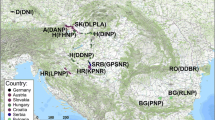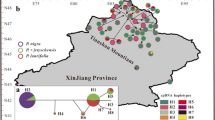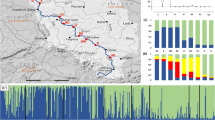Abstract
It is known that various poplar species and cultivated poplar hybrids have the potential to interbreed and produce fertile offspring. Conservation strategies for the genetic resources of the endangered Eurasian black poplar (Populus nigra L.) thus rely on a monitoring which enables the identification and verification of the pure species status. At the same time, the risk of hybrid dispersal and introgressive gene flow has to be estimated. In the present study a combination of two molecular markers, one from chloroplast DNA and the other from nuclear DNA, was applied to evaluate a large P. nigra population on the Elbe River. Hybrid clones of P. × canadensis are scattered within this population and also occur as plantations in the surrounding landscape. By means of the DNA markers the taxonomic status of 208 adult trees in the population and 140 young poplars along the riverbank was monitored. From the analysed young poplars, almost 20 percent were found to exhibit at least one of the two P. deltoides or P. × canadensis diagnostic alleles or genotypes, respectively. Possible vegetative spreads of F1 hybrids and precedent mating scenarios are discussed. Most interestingly we found clear evidence for a small number of backcross hybrids where P. × canadensis acted as pollen donor. This case had long been debated and thought to be less probable, so far.


Similar content being viewed by others
References
Benetka V, Mottl J, Vackovà K, Pospískova M, Dubský M (1999) Estimation of the introgression level in P. nigra L. populations by means isozyme gene markers. Silvae Genet 48:218–223
Bradshaw HD Jr., Villar M, Watson BD, Otto KG, Stewart S, Stettler RF (1994) Molecular genetics of growth and development in Populus III. A genetic linkage map of a hybrid poplar composed of RFLP, STS, and RAPD markers. Theor Appl Genet 89:167–178
Bradshaw HD Jr, Ceulemanns R, Davis J, Stettler R (2000) Emerging model systems in Plant Biology: Poplar (Populus) as a model forest tree. J Plant Growth Regul 19:306–313
Demesure B, Sodzi N, Petit RJ (1995) A set of universal primers for amplification of polymorphic non-coding regions of mitochondrial and chloroplast DNA in plants. Mol Ecol 4:129–131
Dumolin S, Demesure B, Petit RJ (1995) Inheritance of chloroplast and mitochondrial genomes in pedunculate oak investigated with an efficient PCR method. Theor Appl Genet 91:1253–1256
Dynesius M, Nilsson C, (1994) Fragmentation and flow regulation of river systems in the Northern third of the world. Science 266:753–762
Heinze B (1997) A PCR marker for a Populus deltoides allele and its use in studying introgression with native European Populus nigra. Belg J Bot 129:123–130
Heinze B (1998a) PCR-based chloroplast DNA assays for the identification of native Populus nigra and introduced poplar hybrids in Europe. For Genet 5:31–38
Heinze B (1998b) Molekulargenetische Unterscheidung und Identifizierung von Schwarzpappeln und Hybridpappelklonen. = Molecular Genetic Differentiation and Identification of Black Poplars and Hybrid Poplar Clones. In: FBVA-Berichte, vol. 105, Wien
Holderegger R, Angelone S, Brodbeck S, Csencsics D, Gugerli F, Hoebee SE, Finkeldey R (2005) Application of genetic markers to the discrimination of European black poplar (Populus nigra) from American black poplar (P. deltoides) and hybrid poplars (P. × canadensis) in Switzerland. Trees 19:742–747
IKSE, Internationale Kommission zum Schutz der Elbe (1994) Ökologische Studie zum Schutz und Gestaltung der Ge-wässerstrukturen und Uferrandregionen der Elbe. Magdeburg
Imbert E, Lefèvre F (2003) Dispersal and gene flow of Populus nigra L. (Salicaceae) along a dynamic river system. J Ecol 91:447–456
Lefèvre F, Barsoum N, Heinze B, Kajba D, Rotach P, de Vries SMG et al (2001) In situ conservation of Populus nigra. In: EUFORGEN Technical Bulletin. International Plant Genetic Resources Institute, Rome, Italy
Mejnartowicz M (1991) Inheritance of chloroplast DNA in Populus. Theor Appl Genet 82:477–480
Melchior GH, Seitz FW (1968) Interspezifische Kreuzungssterilität innerhalb der Pappelsektion Aigeiros. Silvae Genet 17:88–93
Nettencourt DE (1977) Incompatibility in angiosperms. Springer Verlag, Berlin Heidelberg New York
Niggemann M, Rathmacher G, Bialozyt R (2006) The risk of introgression of foreign genes in Populus spec.—Differences in the flowering phenology of P. nigra and P. × canadensis. In: Hoffmeister T, Diekmann M (eds) Proceedings of the GfÖ, Vol. 36, Bremen, p 91
Primack RB (2002) Essentials of Conservation Biology. 3rd edn. Sinauer Associates, Sunderland
Rajora OP (1989) Pollen competition among Populus deltoides Marsh., P. nigra, L. and P. maximowiczii Henry in fertilizing P. deltoides ovules and siring its seed crop. Sex Plant Reprod 2:90–96
Vanden Broeck A, Cox K, Quataert P, Van Bockstaele E, Van Slycken J (2003) Flowering phenology of Populus nigra L., Populus nigra cv. italica and P. × canadensis Moench. and the potential for natural hybridisation in Belgium. Silvae Genet 52:280–283
Vanden Broeck A, Storme V, Cottrell JE, Boerjan W, Van Bockstale E, Quataert P, Van Slycken J (2004) Gene flow between cultivated poplars and native black poplar (Populus nigra L.): a case study along the river Meuse on the Dutch-Belgian border. For Ecol Manag 197:307–310
Vanden Broeck A, Villar M, Van Bockstaele E, Van Slycken J (2005) Natural hybridization between cultivated poplar and their wild relatives: evidence and consequences for native poplar populations. Ann For Sci 62:601–613
Wachowiak W, Stephan R, Schulze I, Prus-Glowacki W, Ziegenhagen B (2006) A critical evaluation of reproductive barriers between closely related species using DNA markers—a case study in Pinus. Plant Syst Evol 257:1–8
Wolf DE, Takebayashi N, Rieseberg LH (2001) Predicting the risk of extinction through hybridization. Conserv Biol 15:1039–1053
Zsuffa L, Giordono E, Pryor LD, Stettler RF (1996) Trends in poplar culture: some global and regional perspectives. In: Stettler RF, Bradshaw HD, Heilman PE Jr, Hinckley TM (eds) Biology of the Populus. NRC Research Press, Ottawa, pp 515–539
Acknowledgements
We would like to thank Karl Gebhardt, Alwin Janßen and Hans-Jürgen Arndt from the Northwest German Forest Research Centre in Hannoversch-Münden, Germany, for providing the reference material from the poplar clone collection. S.G. had been working periodically in the laboratory of the Federal Research Centre for Forests (BFW), Department of Genetics, Vienna, Austria. Thanks to Thomas Geburek, Thomas Thalmayr and Wilfried Nebenführ for hosting and training her. We are grateful to Christina Mengel for excellent technical support in the laboratory of the Conservation Biology working group at the Philipps-University of Marburg. G.R. is financially supported by a grant of the German Federal Ministry of Education and Research (0313285J: Modelling gene flow in poplar in a real landscape).
Author information
Authors and Affiliations
Corresponding author
Rights and permissions
About this article
Cite this article
Ziegenhagen, B., Gneuss, S., Rathmacher, G. et al. A fast and simple genetic survey reveals the spread of poplar hybrids at a natural Elbe river site. Conserv Genet 9, 373–379 (2008). https://doi.org/10.1007/s10592-007-9349-4
Received:
Accepted:
Published:
Issue Date:
DOI: https://doi.org/10.1007/s10592-007-9349-4




